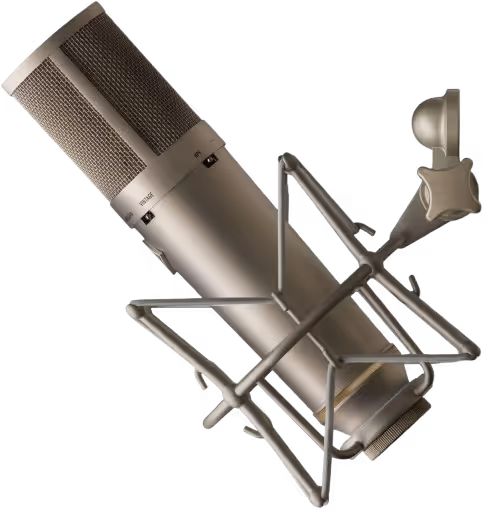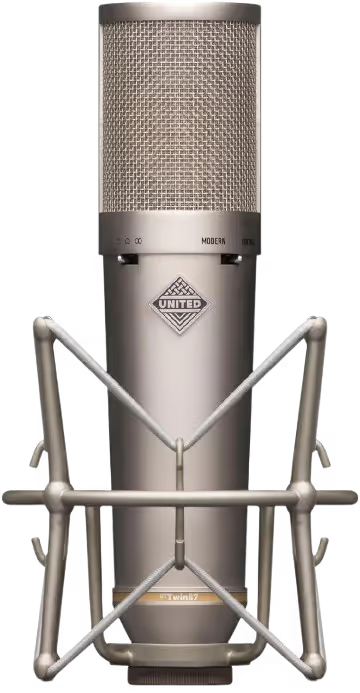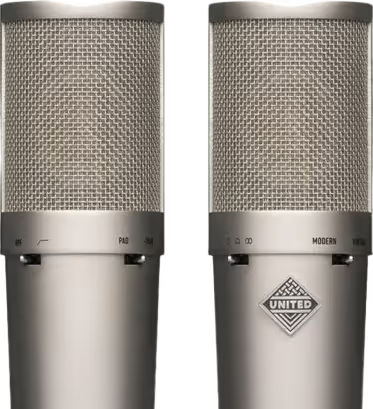United Studio Tech twin87 Review

2022
$599
2kg
220mm (Le) x 55mm (Di)

2022
$599
2kg
220mm (Le) x 55mm (Di)
The United Studio Technologies UT Twin87 is a large-diaphragm condenser based on the classic U87 design. It includes two distinct circuit modes, recreating the tonal differences between vintage and modern production eras of the U87.
Out of the box the UT Twin87 comes with the microphone, a suspension shock mount, and a vintage-style pouch for storage.
The mic is quite large but solid, measuring about 220 mm tall with a 55 mm diameter, and feels heavy in the hand at around 2 kg.

The design follows the familiar shape of the classic U87, with switches placed clearly on the body. On the front you find a selector for three polar patterns: cardioid, omni, and figure-8. Alongside this, there is a -10 dB pad switch for handling louder sources and a high-pass filter to reduce low-end rumble. Moving between polar patterns, engaging the pad, or cutting low frequencies can all be altered easily.
The circuit design is where the model stands out. A switch allows you to choose between a “Vintage” and a “Modern” voicing, based on different production eras of the U87. This effectively gives two distinct tonal options within one microphone.

The internal build includes a 34 mm dual-diaphragm gold-sputtered capsule, a transformer, and FET circuitry that aim to keep noise low while retaining character.
The frequency range extends from 20 Hz to 20 kHz, and it can handle sources up to 127 dB SPL with the pad engaged. The overall impression is of a studio microphone that has been designed to balance classic character with modern flexibility.
The UT Twin87 delivers a balanced and versatile sound that is shaped by its dual circuit design.
In the vintage mode the microphone leans toward a smoother midrange with a slightly softer top end, which can give vocals and instruments a more rounded and classic tone.
In the modern mode the sound opens up, with a brighter high end and more detail, lending itself well to pop or podcast recording. Both modes keep the low end controlled without sounding thin, and the microphone maintains clarity across its frequency range.
On acoustic guitar the mic captures detail in the highs while avoiding excessive brittleness, and on drum overheads it offers a clear stereo image with defined transients.
The microphone handles higher sound levels well, especially with the -10 dB pad engaged, making it suitable for louder sources like guitar amps. Self-noise is low, which helps when recording softer material such as voiceover or quiet instruments. The combination of two circuit voicings and three polar patterns adds flexibility, and it positions the Twin87 as a microphone that can adapt around your studio.
On the front of the body is the main pattern switch, which offers cardioid, omni, and figure-8 modes. This allows the microphone to adapt from close-up vocal recording to wider stereo and ambient capture. Just below are two additional switches: a -10 dB pad for managing high sound pressure levels, and a high-pass filter set at 80 Hz to reduce unwanted low frequencies from proximity effect or room rumble.

Another distinctive feature is the RF filter, designed to minimise interference from electronic devices and radio signals. What separates the Twin87 from other microphones in its range is the dual circuit design.
While the Neumann remains a studio standard with decades of proven use, the UT Twin87 provides a more affordable alternative that captures much of the same character.
Compared to other microphones in its price range, such as the Warm Audio WA-87 or the Aston Spirit, the Twin87 stands out for its ability to switch between vintage and modern voicings.
We conclude the Twin87 as a versatile option in its budget bracket.
The UT Twin87 suits engineers and musicians who want a large-diaphragm condenser with the tonal qualities to capture string instruments.
Vocalists will find it useful for both modern and vintage styles, since the two circuit modes provide options for brighter, detailed delivery or a smoother, softer sound.
Home studios benefit from its three polar patterns, making it capable of handling solo vocals, acoustic instruments, room ambience, or group recordings.
Producers working across multiple genres may value the flexibility to shift between clean detail and warmer colour without changing microphones.
It is also a good mic for podcasters and voiceover work, where its low self-noise and balanced tone help keep spoken word clear and natural. Those working in treated rooms will get the most out of its sensitivity and extended response, though with careful placement it can still perform well in less controlled spaces.
While it does not fully replace the detail and heritage of a genuine U87, it provides a alternative at a lower cost, with features that make it adaptable across the studio.